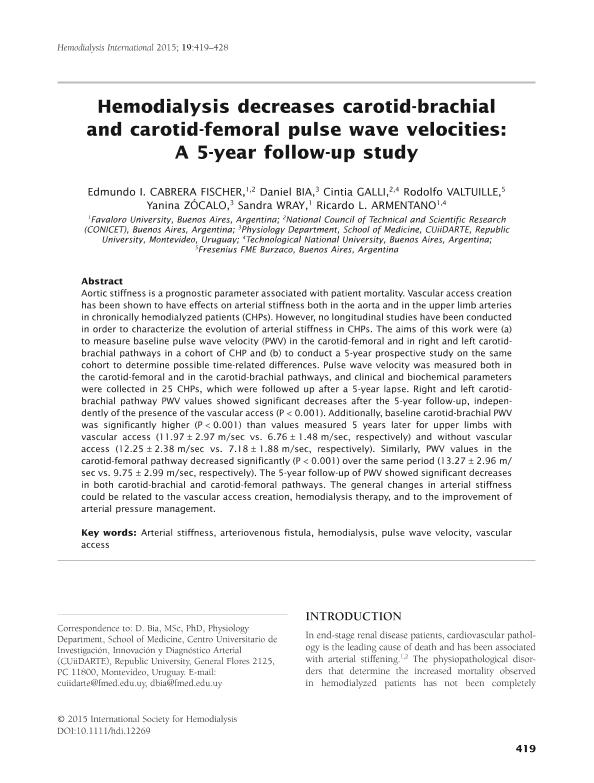Artículo
Hemodialysis decreases carotid-brachial and carotid-femoral pulse wave velocities: A 5-year follow-up study
Cabrera Fischer, Edmundo Ignacio ; Bia, Daniel; Galli, Cintia Nora; Valtuille, Rodolfo; Zócalo, Yanina; Wray, Sandra; Armentano, Ricardo Luis
; Bia, Daniel; Galli, Cintia Nora; Valtuille, Rodolfo; Zócalo, Yanina; Wray, Sandra; Armentano, Ricardo Luis
 ; Bia, Daniel; Galli, Cintia Nora; Valtuille, Rodolfo; Zócalo, Yanina; Wray, Sandra; Armentano, Ricardo Luis
; Bia, Daniel; Galli, Cintia Nora; Valtuille, Rodolfo; Zócalo, Yanina; Wray, Sandra; Armentano, Ricardo Luis
Fecha de publicación:
03/2015
Editorial:
Wiley Blackwell Publishing, Inc
Revista:
Hemodialysis International
ISSN:
1492-7535
Idioma:
Inglés
Tipo de recurso:
Artículo publicado
Clasificación temática:
Resumen
Aortic stiffness is a prognostic parameter associated with patient mortality. Vascular access creation has been shown to have effects on arterial stiffness both in the aorta and in the upper limb arteries in chronically hemodialyzed patients (CHPs). However, no longitudinal studies have been conducted in order to characterize the evolution of arterial stiffness in CHPs. The aims of this work were (a) to measure baseline pulse wave velocity (PWV) in the carotid-femoral and in right and left carotidbrachial pathways in a cohort of CHP and (b) to conduct a 5-year prospective study on the same cohort to determine possible time-related differences. Pulse wave velocity was measured both in the carotid-femoral and in the carotid-brachial pathways, and clinical and biochemical parameters were collected in 25 CHPs, which were followed up after a 5-year lapse. Right and left carotidbrachial pathway PWV values showed significant decreases after the 5-year follow-up, independently of the presence of the vascular access (P < 0.001). Additionally, baseline carotid-brachial PWV was significantly higher (P < 0.001) than values measured 5 years later for upper limbs with vascular access (11.97 ± 2.97 m/sec vs. 6.76 ± 1.48 m/sec, respectively) and without vascular access (12.25 ± 2.38 m/sec vs. 7.18 ± 1.88 m/sec, respectively). Similarly, PWV values in the carotid-femoral pathway decreased significantly (P < 0.001) over the same period (13.27 ± 2.96 m/ sec vs. 9.75 ± 2.99 m/sec, respectively). The 5-year follow-up of PWV showed significant decreases in both carotid-brachial and carotid-femoral pathways. The general changes in arterial stiffness could be related to the vascular access creation, hemodialysis therapy, and to the improvement of arterial pressure management.
Palabras clave:
ARTERIAL STIFFNESS
,
ARTERIOVENOUS FISTULA
,
HEMODIALYSIS
,
PULSE WAVE VELOCITY
Archivos asociados
Licencia
Identificadores
Colecciones
Articulos(SEDE CENTRAL)
Articulos de SEDE CENTRAL
Articulos de SEDE CENTRAL
Citación
Cabrera Fischer, Edmundo Ignacio; Bia, Daniel; Galli, Cintia Nora; Valtuille, Rodolfo; Zócalo, Yanina; et al.; Hemodialysis decreases carotid-brachial and carotid-femoral pulse wave velocities: A 5-year follow-up study; Wiley Blackwell Publishing, Inc; Hemodialysis International; 19; 3; 3-2015; 419-428
Compartir
Altmétricas



